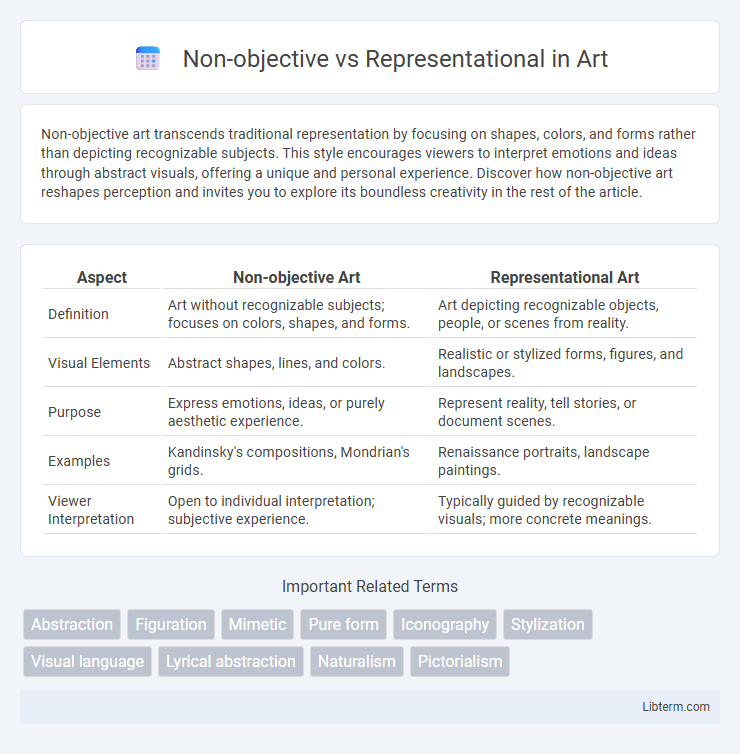Non-objective art transcends traditional representation by focusing on shapes, colors, and forms rather than depicting recognizable subjects. This style encourages viewers to interpret emotions and ideas through abstract visuals, offering a unique and personal experience. Discover how non-objective art reshapes perception and invites you to explore its boundless creativity in the rest of the article.
Table of Comparison
| Aspect | Non-objective Art | Representational Art |
|---|---|---|
| Definition | Art without recognizable subjects; focuses on colors, shapes, and forms. | Art depicting recognizable objects, people, or scenes from reality. |
| Visual Elements | Abstract shapes, lines, and colors. | Realistic or stylized forms, figures, and landscapes. |
| Purpose | Express emotions, ideas, or purely aesthetic experience. | Represent reality, tell stories, or document scenes. |
| Examples | Kandinsky's compositions, Mondrian's grids. | Renaissance portraits, landscape paintings. |
| Viewer Interpretation | Open to individual interpretation; subjective experience. | Typically guided by recognizable visuals; more concrete meanings. |
Understanding Non-Objective Art
Non-objective art emphasizes elements such as color, form, line, and texture without depicting recognizable objects or scenes, allowing viewers to experience pure visual sensation. Understanding non-objective art involves appreciating abstract compositions where meaning arises from the interaction of shapes and hues rather than representational content. This form challenges traditional art by prioritizing emotional and intellectual responses over literal interpretation.
Defining Representational Art
Representational art depicts recognizable subjects from the real world, such as people, landscapes, and objects, aiming to create a visual likeness. It emphasizes accurate detail, perspective, and form to convey a realistic or idealized interpretation of reality. This style contrasts with non-objective art, which avoids identifiable subjects and focuses on abstract elements like color, shape, and texture.
Key Characteristics of Non-Objective Works
Non-objective art emphasizes pure form, color, and line without representing specific objects or scenes, focusing on abstract elements to evoke emotions or ideas. It often employs geometric shapes, dynamic compositions, and a lack of recognizable subjects, distinguishing it from representational art's depiction of real-world imagery. Key characteristics include an emphasis on visual language independent of reality, prioritizing aesthetic exploration over narrative or figurative content.
Visual Elements in Representational Art
Representational art emphasizes recognizably realistic visual elements such as shapes, colors, and textures that mirror objects from the real world, enabling viewers to identify subjects with clarity. Detailed use of light, shadow, and perspective enhances dimensionality and spatial relationships, adding to the artwork's lifelike quality. This contrasts with non-objective art, where visual elements are abstracted or non-referential, prioritizing composition and form over identifiable subjects.
Historical Origins of Both Art Forms
Non-objective art emerged in the early 20th century, rooted in movements like Cubism and Suprematism, emphasizing shapes, colors, and forms without depicting recognizable objects. Representational art traces back to prehistoric cave paintings and classical antiquity, focusing on realistic depictions of subjects from the observable world. The divergence between these forms reflects a historical shift from mimetic representation to abstract expression in the evolution of modern art.
Philosophical Differences
Non-objective art rejects the depiction of recognizable subjects, emphasizing pure form, color, and composition to evoke emotional or intellectual responses independent of physical reality. Representational art aims to accurately depict objects or scenes from the observable world, grounding its meaning in shared human experience and visual recognition. Philosophically, non-objective art challenges the notion of reality as a fixed entity, promoting abstraction and subjective interpretation, whereas representational art affirms the external world's existence and our ability to reflect it through perception.
Techniques Used in Non-Objective vs Representational Art
Non-objective art employs techniques such as geometric abstraction, color field painting, and spontaneous brushwork to convey emotions and ideas without depicting recognizable objects. Representational art uses techniques like perspective, shading, and anatomical accuracy to create lifelike images and scenes. Both styles leverage texture, color theory, and composition, but non-objective art emphasizes abstraction and the viewer's interpretation, whereas representational art focuses on realistic representation and narrative clarity.
Notable Artists and Their Styles
Non-objective art features artists like Wassily Kandinsky and Kazimir Malevich, who emphasized abstract forms and colors free from recognizable subjects, prioritizing pure expression and emotional resonance. Representational art includes key figures such as Leonardo da Vinci and Johannes Vermeer, renowned for their detailed, lifelike depictions of the human figure, nature, and everyday scenes reflecting reality. Both styles significantly influence art history, with non-objective art advancing abstraction and representational art preserving traditional realism and narrative.
Emotional Impact and Viewer Interpretation
Non-objective art emphasizes abstract forms and colors, creating an open-ended emotional impact that encourages personal interpretation and introspection. Representational art depicts recognizable subjects, guiding viewers toward specific emotions and narratives anchored in reality. The emotional response in non-objective works often varies widely, while representational pieces typically evoke more consistent and culturally shared feelings.
Contemporary Relevance in the Art World
Non-objective art, characterized by abstract forms and the absence of recognizable subjects, continues to influence contemporary art by challenging traditional perceptions and encouraging innovative visual language. Representational art remains vital, connecting audiences through familiar imagery and narratives that reflect current social and cultural issues. Both styles coexist in today's art world, driving diverse creative expressions and dialogues on identity, reality, and interpretation.
Non-objective Infographic

 libterm.com
libterm.com